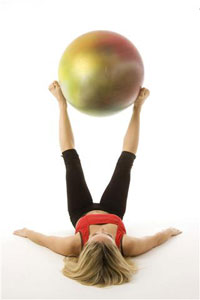Staying fit in winter
For many people, the only thing that becomes ‘more firm’ in the winter months is their resolve to stay indoors and keep warm.
In order to maintain health and fitness throughout the year, there is a need to find forms of exercise that can be carried out regardless of the weather conditions and to incorporate them into your routine.
Pilates is one such option. More than just a way to keep out of the rain while you work up a sweat, Pilates has been described as ‘the closest thing you’ll get to the perfect workout’.
Developed by Joseph Pilates during the First World War to facilitate rehabilitation of soldiers, the principles of Pilates are designed to condition the entire body through focus on alignment, core strength, breathing and flowing movement.
The toned limbs and flat stomachs of modern Pilates celebrity devotees such as Madonna and Jennifer Aniston demonstrate the application of Pilates far beyond recovery from injury.
Many people are taking advantage of the improvement in muscle control and tone, flexibility, balance, breathing pattern, and posture that Pilates is designed to achieve.
Pilates works on creating stability in the lower back and pelvic region, which allows the body to move with greater efficiency and form.
Exercises are mainly floor-based, using gravity to provide resistance, and small pieces of equipment such as exercise balls and resistance bands.
Other classes are studio based, using equipment such as ‘the reformer’ or a ‘trapeze table’ that can be adjusted through many permutations to facilitate strengthening and stretching – in lying, sitting, standing and kneeling positions.
There is a wide variety of exercises, and progress is graded through the program, so Pilates is constantly challenging and combats the boredom that often accompanies indoor fitness pursuits.
Individualised programs can be created by certified Pilates instructors to address specific postural and strengthening needs.
Pilates is suitable for a range of age and fitness levels, from individuals recovering from surgery or with significant back pain, to dancers and high level athletes looking to optimise their power and stability.
Many Olympic athletes, particularly gymnasts, divers and rowers, incorporate Pilates in their training regimens.
The exercise is ‘low impact’ and so is kind to your joints, while working your muscles hard.
This also makes Pilates particularly suitable for women who are pregnant or recovering from childbirth, especially given its benefits in strengthening the lower abdominals and pelvic floor.
Because Pilates constitutes weight-bearing exercise, it improves bone density. This is an important consideration for women of all ages in order to combat osteoporosis.
Although programs can be adjusted to facilitate weight loss and aerobic fitness, Pilates is not primarily designed to accomplish these aims.
With the increasing popularity of this form of exercise, there are many Pilates studios available in Perth.
Floor-based classes may also be run at your local gymnasium.
The instructor should have comprehensive certification in the Pilates method.
Class sizes and prices vary, so it is worth shopping around.
Floor based classes tend to be larger (around 15 people) and cheaper, starting at around $15 per class.
Clinical Pilates classes are led by physiotherapists, usually within physiotherapy practices.
Clinical Pilates and studio sessions consist of small groups (2-5 people), and last about an hour.
Many studios recommend an initial consultation to assess posture, and carry out ultrasound to assess function of the deep abdominal muscles.
This enables feedback regarding appropriate abdominal contraction, and the creation of a program tailored to your individual needs.
Clinical Pilates prices vary, costing between $35 and $85 per session, depending on which health fund rebates may apply.
Pilates is a safe, effective form of exercise that can be practiced all year round.
It can be enjoyed just as much by athletes as by those who have found other forms of exercise unsuitable in the past.
The health benefits of Pilates are diverse and significant.
So if the idea of running in the rain, the thought of aggravating your aching joints, or the monotony of another session at the gym doesn’t make you feel warm inside, consider Pilates before resigning yourself to another winter with your feet up and your heart-rate down.
Dates
Tags
Created by:

 Login
Login














